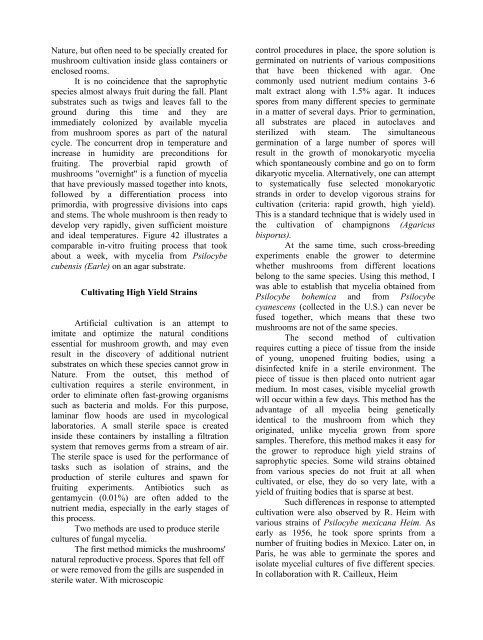Jochen Gartz - Magic Mushrooms Around the ... - preterhuman.net
Jochen Gartz - Magic Mushrooms Around the ... - preterhuman.net
Jochen Gartz - Magic Mushrooms Around the ... - preterhuman.net
Create successful ePaper yourself
Turn your PDF publications into a flip-book with our unique Google optimized e-Paper software.
Nature, but often need to be specially created for<br />
mushroom cultivation inside glass containers or<br />
enclosed rooms.<br />
It is no coincidence that <strong>the</strong> saprophytic<br />
species almost always fruit during <strong>the</strong> fall. Plant<br />
substrates such as twigs and leaves fall to <strong>the</strong><br />
ground during this time and <strong>the</strong>y are<br />
immediately colonized by available mycelia<br />
from mushroom spores as part of <strong>the</strong> natural<br />
cycle. The concurrent drop in temperature and<br />
increase in humidity are preconditions for<br />
fruiting. The proverbial rapid growth of<br />
mushrooms "overnight" is a function of mycelia<br />
that have previously massed toge<strong>the</strong>r into knots,<br />
followed by a differentiation process into<br />
primordia, with progressive divisions into caps<br />
and stems. The whole mushroom is <strong>the</strong>n ready to<br />
develop very rapidly, given sufficient moisture<br />
and ideal temperatures. Figure 42 illustrates a<br />
comparable in-vitro fruiting process that took<br />
about a week, with mycelia from Psilocybe<br />
cubensis (Earle) on an agar substrate.<br />
Cultivating High Yield Strains<br />
Artificial cultivation is an attempt to<br />
imitate and optimize <strong>the</strong> natural conditions<br />
essential for mushroom growth, and may even<br />
result in <strong>the</strong> discovery of additional nutrient<br />
substrates on which <strong>the</strong>se species cannot grow in<br />
Nature. From <strong>the</strong> outset, this method of<br />
cultivation requires a sterile environment, in<br />
order to eliminate often fast-growing organisms<br />
such as bacteria and molds. For this purpose,<br />
laminar flow hoods are used in mycological<br />
laboratories. A small sterile space is created<br />
inside <strong>the</strong>se containers by installing a filtration<br />
system that removes germs from a stream of air.<br />
The sterile space is used for <strong>the</strong> performance of<br />
tasks such as isolation of strains, and <strong>the</strong><br />
production of sterile cultures and spawn for<br />
fruiting experiments. Antibiotics such as<br />
gentamycin (0.01%) are often added to <strong>the</strong><br />
nutrient media, especially in <strong>the</strong> early stages of<br />
this process.<br />
Two methods are used to produce sterile<br />
cultures of fungal mycelia.<br />
The first method mimicks <strong>the</strong> mushrooms'<br />
natural reproductive process. Spores that fell off<br />
or were removed from <strong>the</strong> gills are suspended in<br />
sterile water. With microscopic<br />
control procedures in place, <strong>the</strong> spore solution is<br />
germinated on nutrients of various compositions<br />
that have been thickened with agar. One<br />
commonly used nutrient medium contains 3-6<br />
malt extract along with 1.5% agar. It induces<br />
spores from many different species to germinate<br />
in a matter of several days. Prior to germination,<br />
all substrates are placed in autoclaves and<br />
sterilized with steam. The simultaneous<br />
germination of a large number of spores will<br />
result in <strong>the</strong> growth of monokaryotic mycelia<br />
which spontaneously combine and go on to form<br />
dikaryotic mycelia. Alternatively, one can attempt<br />
to systematically fuse selected monokaryotic<br />
strands in order to develop vigorous strains for<br />
cultivation (criteria: rapid growth, high yield).<br />
This is a standard technique that is widely used in<br />
<strong>the</strong> cultivation of champignons (Agaricus<br />
bisporus).<br />
At <strong>the</strong> same time, such cross-breeding<br />
experiments enable <strong>the</strong> grower to determine<br />
whe<strong>the</strong>r mushrooms from different locations<br />
belong to <strong>the</strong> same species. Using this method, I<br />
was able to establish that mycelia obtained from<br />
Psilocybe bohemica and from Psilocybe<br />
cyanescens (collected in <strong>the</strong> U.S.) can never be<br />
fused toge<strong>the</strong>r, which means that <strong>the</strong>se two<br />
mushrooms are not of <strong>the</strong> same species.<br />
The second method of cultivation<br />
requires cutting a piece of tissue from <strong>the</strong> inside<br />
of young, unopened fruiting bodies, using a<br />
disinfected knife in a sterile environment. The<br />
piece of tissue is <strong>the</strong>n placed onto nutrient agar<br />
medium. In most cases, visible mycelial growth<br />
will occur within a few days. This method has <strong>the</strong><br />
advantage of all mycelia being ge<strong>net</strong>ically<br />
identical to <strong>the</strong> mushroom from which <strong>the</strong>y<br />
originated, unlike mycelia grown from spore<br />
samples. Therefore, this method makes it easy for<br />
<strong>the</strong> grower to reproduce high yield strains of<br />
saprophytic species. Some wild strains obtained<br />
from various species do not fruit at all when<br />
cultivated, or else, <strong>the</strong>y do so very late, with a<br />
yield of fruiting bodies that is sparse at best.<br />
Such differences in response to attempted<br />
cultivation were also observed by R. Heim with<br />
various strains of Psilocybe mexicana Heim. As<br />
early as 1956, he took spore sprints from a<br />
number of fruiting bodies in Mexico. Later on, in<br />
Paris, he was able to germinate <strong>the</strong> spores and<br />
isolate mycelial cultures of five different species.<br />
In collaboration with R. Cailleux, Heim








![The Big Lie 9-11 and Government Complicity in Mass Murder [PDF]](https://img.yumpu.com/50957077/1/190x245/the-big-lie-9-11-and-government-complicity-in-mass-murder-pdf.jpg?quality=85)








